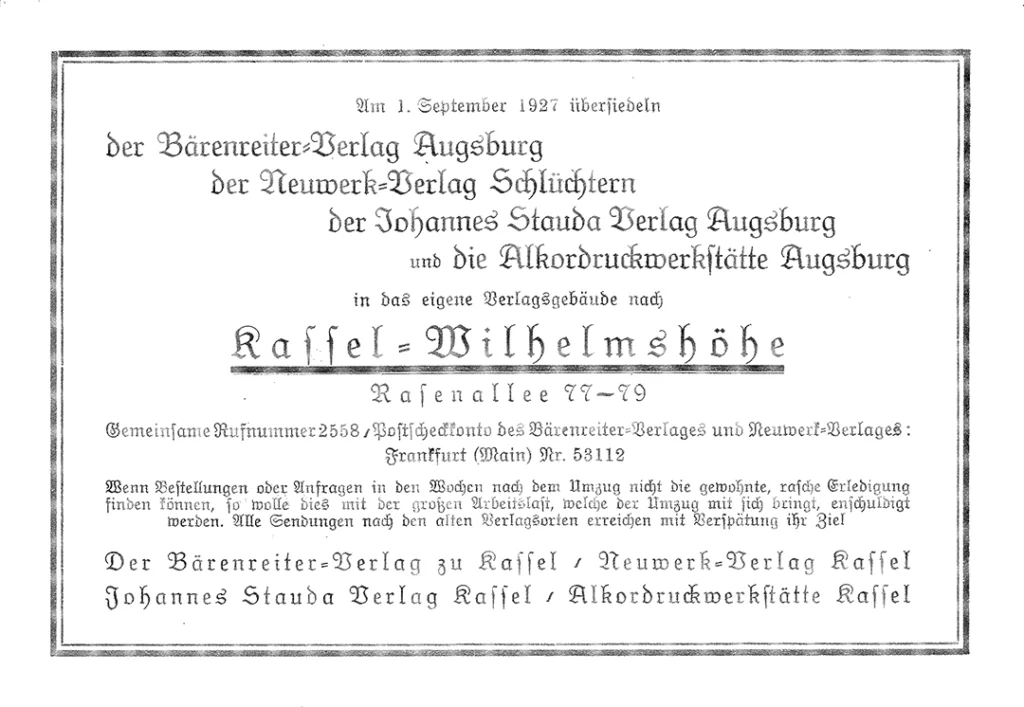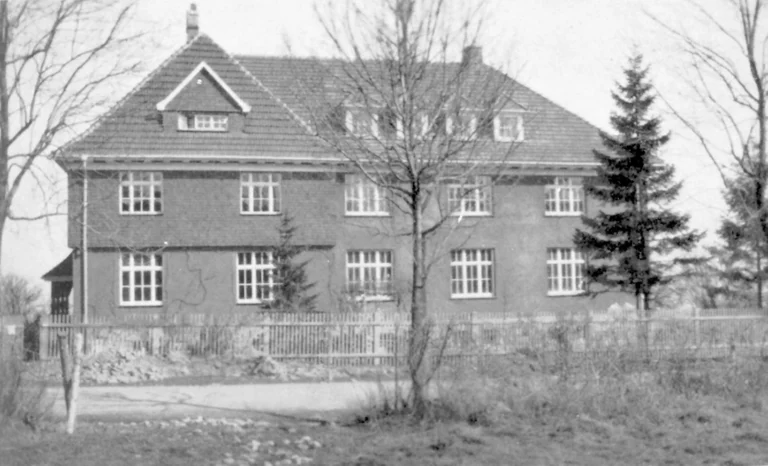From Augsburg to Kassel, from folk song to Schütz
Bärenreiter’s early years
22 March 1926 was a date of far-reaching significance for the young publishing house, which had already moved into its own premises in 1925: Richard Baum, who had just received his doctorate from the University of Munich, joined Gertraud Hahn, who had been Karl Vötterle’s right hand since 1924, as an editor – little did he know that he would stay at Bärenreiter for more than fifty years! Vötterle later joked that this was the meeting of a musicologist with no idea of publishing and a young publisher with no idea of musicology,[i] and at first it did indeed seem like the collision of two different worlds: Baum was relieved when, on his first day at work, his boss “came to meet him wearing long trousers and a tie, rather than his hiking gear”.[ii] However, the two fields were not actually as alien as it might seem: as early as 1923, Vötterle had been able to get Hans-Joachim Moser, a young professor from Halle, to be a judge at a singing convention in Fürstenfeldbruck, and he had met Konrad Ameln, who was studying with Joseph Müller-Blattau in Königsberg (today’s Kaliningrad), at a singing week. The 1925 catalogue already reflects this “intersection”. The Locheimer Liederbuch edited by Ameln and Müller-Blattau’s edition of Forkel’s Bach biography were two weighty new publications. Besides these – in addition to Wilhelm Hensel’s folk songbooks, which were published monthly, and numerous theological writings – the catalogue contained practical editions of selected works by Johann Sebastian Bach, John Dowland, Hans Leo Haßler, and Leonhard Lechner, which had been produced by experienced musicians such as the lute specialist Heinz Bischoff and the music educator Walther Pudelko. The field had thus already been tilled, and Richard Baum’s work could begin.
In the early years, Bärenreiter’s portfolio primarily contained vocal music by old masters, but after 1926, more and more instrumental works were added. This did not clash with the premises of the Singbewegung, but was essentially a consistent development: chorales and sacred songs had already been performed in Finkenstein, and chamber music had been an integral part of the evening entertainment there. A further dynamic was set in motion by the 1927 Freiburg Organ Conference, which provided the initial impetus for church music and the German organ movement in much the same way that Finkenstein had for the Singbewegung. Karl Vötterle – who was an active member of the Berneuchen Circle, which advocated a sacramental renewal of the church and thus pursued ideas similar to those of the Singbewegung in the field of music – published the conference proceedings; new editors such as Hermann Keller and Karl Matthaei brought out standard-setting editions of organ music, some of which are still in Bärenreiter’s catalogue today. The title of the journal Musik und Kirche, which first appeared in 1929 and was edited by Christhard Mahrenholz, showed where the company was heading: Bärenreiter was increasingly establishing a profile as a music publisher with a decidedly theological bent – a development that placed the company’s very existence at risk during the National Socialist era, but received public recognition in 1953, when Karl Vötterle was awarded honorary doctorates in musicology (University of Kiel) and Protestant theology (University of Leipzig).
In the late 1920s, Bärenreiter’s early music editions started to attract the attention of musicologists. Alfred Einstein, who saw the publisher’s portfolio as evoking “a kind of new musical Nazarenism”, gave it his vote of confidence: “Music research is watching this endeavour with silent pleasure, and – whatever may arise from these beginnings and doings –: the objective knowledge of the past will profit from it.”[iii] One name in particular came into focus more and more: Heinrich Schütz. The Historia der Auferstehung Jesu Christi, the Musikalische Exequien and the first volumes of the Geistliche Chormusik 1648 were among Bärenreiter’s first new editions (as was Einstein’s biography), published from 1929 onwards. In 1930, Vötterle became one of the founders of the Neue Schütz-Gesellschaft, at whose music festivals the composer’s works were performed and which, after the War, commissioned Bärenreiter to produce a new complete edition of Schütz. Fifty years after joining the publishing house, Richard Baum admitted that in retrospect, this concentration on the old masters was surprising and also raised some doubts: “I have often asked myself whether I was partly to blame for the fact that, at the time Schoenberg was writing his ‘Moses and Aaron’, Stravinsky his ‘Symphony of Psalms’, and Alban Berg his Violin Concerto, we passed this chapter of European music by and, in grand one-sidedness, published old masters. But I console myself that in this way a very important chapter in the history of European music was opened up, a chapter that subsequently and to this day has helped countless people to both broaden and deepen their music-making.”[iv]
Finally, an important event: in 1927, Karl Vötterle met Maria Zeiß, who came from Kassel, at a singing week. It was Maria’s father who lured the publisher to northern Hesse when Vötterle decided to expand his premises and was unable to find the right conditions for doing so in Augsburg. Thanks to a plot of land on the Wilhelmshöhe and a loan brokered without the usual red tape by Lord Mayor Herbert Stadler, several goods wagons laden with Bärenreiter stock already rolled north that very summer. Six of fourteen employees moved to Kassel along with Vötterle; new staff joined. On September 10, 1927, the young couple were married in Kassel’s Martinskirche by Hermann Schafft, and Karl Vötterle had found something he had long desired: a city that was not just a place of work, but also offered the opportunity to become involved in and influence its cultural life. “These were years of awakening and reflection, exhilarating years in which we – surrendered to the new vista opening up before us – stood apart from political life and failed to see what was coming.”[v]
Gudula Schütz
[i] Das Bärenreiter-Werk 21, 1972, p. 8.
[ii] Ibid. 15, 1966, p. 12.
[iii] A[lfred] E[instein], Bücherschau, in: Zeitschrift für Musikwissenschaft 5, 1927, p. 310.
[iv] Das Bärenreiter-Werk 25, 1976, p. 38f.
[v] Karl Vötterle, Haus unterm Stern, Kassel 41969, p. 92.



